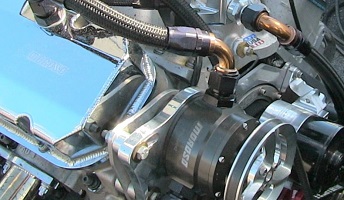vacuum leak detector
vacuum leak detector
1. How does the Prowler sensor work?
As refrigerant gas enters the sensor, a tiny chemical reaction occurs that results in an electrical change inside the sensor element. This change (which is completely reversible and not depleting) is then detected by a microprocessor (computer chip) that translates the chemical reaction into an alarm signal.
2. How does the Prowler sensor compare to heated sensor leak detectors?
Besides having superior sensitivity, especially to the newer HFC refrigerants, the Prowler sensor also operates at a lower temperature than heated sensors. This is an advantage because it draws less current and doesn’t require the use of rechargeable batteries. Another advantage is that it can be used safely in combustible atmospheres.
3. What happens when the Prowler detects that a leak is present?
When refrigerant gas enters the sensor, the Prowler detection circuit initiates three indicators that show a leak is present. The user hears an audio alarm (when not manually muted), feels a vibration in the handle, and sees the bar graph line(s) appearing on the LCD screen. Both the audio and vibration alarm are constant no matter how large the concentration of the gas. The LCD bar graph changes depending on the concentration of the gas in the sensor. The bar graph is also independent from the sensitivity level selected.
4. How does the Prowler work so that the source of the leak can be located?
Unlike other leak detectors, the Prowler incorporates several innovative high technology features that allow the user to find the source of the leak without requiring any manual adjustments. Advanced computer software constantly monitors the surroundings for the presence of refrigerant gas. The detector then automatically calibrates itself so that it alarms only when it senses an increase in the level of refrigerant as the source of the leak is approached. The proprietary software then “filters” out and virtually eliminates any unwanted (false) alarm signals that occur away from the leak source.
5. Will the Prowler detect large leaks without any manual adjustments?
Yes. However, if the Prowler alarms initially close to a large leak and then stops alarming before the source of the leak can be pin pointed, it means that the concentration of refrigerant in the area near the leak is similar to the concentration at the leak source. In this situation, it is important to move the sensor away from the leak source (usually above the suspected leak source) for 5 to 10 seconds to allow the sensor to self calibrate to a lower concentration before searching the area a second time. The detector will then alarm again closer to (or at) the source of the leak. Holding the probe away in this manner will also give a more accurate indication of the leak size on the bar graph.
6. Will the Prowler alarm when entering a work area contaminated with refrigerant?
Yes. Nevertheless, you must always turn on the Prowler outside of the work area (in clean air) and allow it to complete the warm up cycle before entering an area where a large leak is suspected. The Prowler will alarm initially but will automatically self calibrate to the surroundings and will not alarm again until a larger concentration closer to the source of the leak is detected.
7. Why does the alarm stop sounding when the sensor is held static at a leak source?
This is normal and demonstrates how the detector automatically resets (self calibrates) itself to the ambient. Once the Prowler alarms near the area of the leak, it should be moved away from the leak and back again to verify the exact location and size of the leak. If the leak is large (more than five bars), it may be necessary to move the sensor away from the leak area for 5 to 10 seconds.
8. Can the Prowler determine the size of the leak?
Yes, once the leak has been pin pointed the maximum number of bars on the LCD screen will give the user an idea of the size of the leak. If the leak is large, (5 bars or more) it may be necessary to hold the detector away from the leak for 5 to 10 seconds in order for the circuit to reset completely and to give an accurate indication of the leak size.
9. What does the Prowler do when it is turned on and is going through the warm up mode?
When turned on, the Prowler begins to energize and condition the sensor for use. During this period, the unit will beep at a slow rate and the LCD bar graph will display the conditioning progress by gradually increasing. Warm up is complete when all 10 bars are shown on the display. The beep rate will also increase and the sensitivity level will default to Medium. NOTE: The bars on the bar graph may increase up initially and then down again before increasing to 10 full bars – this is normal.
10. How should the Prowler be tested to make sure it is working properly prior to leak searching?
The preferred method to test the Prowler is with the Leak Test Vial that is included with the leak detector. Although the Vial does not contain refrigerant gas or liquid (this is prohibited), the media in the Vial accurately simulates a small to medium refrigerant gas leak. To test with the Vial, power on the Prowler by depressing the on/off button, allow the instrument time (up to 20 seconds) to energize the sensor, remove the plastic label seal on the top of the Leak Test Vial, and place the sensor closer to the small hole in the top of the Vile. The beep rate should increase and the Leak Size Bar Graph should display a minimum of three bars. The detector will calibrate itself to the Leak Test Vial if the sensor is held static close to the hole in the cap and will not alarm again until it is moved away and allowed to reset. Consecutive testing at the cap and moving away from Vial will eventually result in the detector calibrating itself to the Vial. In this case, the Prowler may require additional time away from the Vial in order to reset before it will alarm again at the Leak Vial. Never use the Leak Test Vial with the cap removed from the bottle. NOTE: If the detector has been out of use for weeks, it may be necessary to set the sensitivity level to HI initially when testing the Prowler with the Leak Test Vial.
11. Is there a way to test the Prowler with Refrigerant Gas before leak checking:
If it is necessary to test the Prowler with refrigerant gas, a small leak can be simulated by removing a Schrader valve cap on an access port of an HVAC system and waiting a few minutes for the accumulated gas to escape. Cracking open and quickly closing the valve on a cylinder of refrigerant is another option; however, the area around the valve should be fanned to allow the gas to dissipate before testing with the Prowler. This test method is not advisable because it is difficult to control the amount of gas emitted from a refrigerant cylinder. Opening and closing the valve on a cylinder typically emits a large volume of refrigerant, which is not representative of an actual leak in an HVAC system. If the Prowler is tested this way, the procedure for finding large leaks (see above) should be followed. If the procedure for finding large leaks is not followed, the automatic calibration feature of the Prowler may cause it to appear to be insensitive.
12. Will the Prowler sensor become damaged if it is exposed to a heavy stream of gas coming from the valve of a refrigerant cylinder?
No. However, exposing the sensor to a heavy stream of refrigerant will cause the sensor to “saturate” and it may take up to 15 or more seconds for the sensor to automatically calibrate and reset to its maximum sensitivity level. For this reason, using a refrigerant cylinder is not an advisable means to test the sensitivity of the Prowler to any particular refrigerant.
13. How can you claim the sensor will last up to 10 years?
The Prowler utilizes sensor technology that is based on room monitoring where sensors are required to be functioning continuously for years. Sensors used for this purpose cannot be depleted when contaminated with refrigerant or require any adjustment to operate at peak performance after running continuously for long periods. By converting continuous use into daily use, for a typical HVAC technician, it was determined using controlled test methods that the sensor would last more than 10 years (under ideal conditions). The sensor life test data was derived after testing the Prowler sensors continuously over a period of time.



